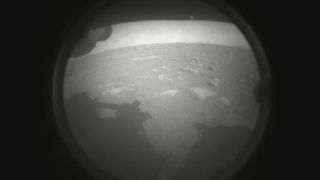
NASA's Perseverance rover isn't ready to start rolling on Mars just yet.
The SUV-sized Perseverance landed inside Mars' 28-mile-wide (45 kilometers) Jezero Crater yesterday (Feb. 18), kicking off an ambitious surface mission that will hunt for signs of ancient Red Planet life and collect dozens of samples for future return to Earth, among other tasks.
But it'll likely be a few months before Perseverance, the heart of NASA's $2.7 billion Mars 2020 mission, really starts sinking its teeth into that science work.
Related: Here's the 1st photo from NASA's Perseverance rover!
Live updates: Follow the Perseverance Mars rover mission
Book of Mars: $22.99 at Magazines Direct
Within 148 pages, explore the mysteries of Mars. With the latest generation of rovers, landers and orbiters heading to the Red Planet, we're discovering even more of this world's secrets than ever before. Find out about its landscape and formation, discover the truth about water on Mars and the search for life, and explore the possibility that the fourth rock from the sun may one day be our next home.
Join our forums here to discuss the Perseverance Mars rover landing. What do you hope finds?
For starters, the rover's handlers will spend the next few Martian days, or sols, getting Perseverance up to speed in its new digs. (A sol lasts 24 hours and 40 minutes, just slightly longer than an Earth day.) The team will stabilize the six-wheeled robot's power, thermal and communications systems so that it's ready to switch over to new, surface-tailored flight software (which is already on the rover), Mars 2020 deputy project manager Jennifer Trosper said during a post-landing news conference yesterday.
As this "critical infrastructure" work is proceeding, "we're also doing other health checks of other instruments," said Trosper, who's based at NASA's Jet Propulsion Laboratory in Southern California. "Over the course of the three sols or four sols of these early activities, we'll get all the instrument health checks done; we'll charge the rover battery."
Perseverance's head-like, instrument-laden mast will also be deployed in these first few sols, allowing great new imagery to be captured. For example, the rover's MastCam-Z camera system is scheduled to take its first color panoramas on sol 3, Trosper said. (Landing day was sol 0, and today, Feb. 19, is sol 1.)
Get the Space.com Newsletter
Breaking space news, the latest updates on rocket launches, skywatching events and more!
The software switch will begin on sol 4, if all goes according to plan. And that important step will take some time to complete.
"Once we start to do that, we do about four days of transitioning to the new software," Trosper said. "We do it very carefully. We toe-dip; we make sure that nothing goes wrong, and at the end of that is when we start the next set of checkouts where we'll deploy the arm. We'll do our first drive — about five meters forward and back."
Related: NASA's Mars 2020 rover mission in pictures
The test driving will ready Perseverance for its first big trip — a journey to a Martian airfield. The mission team will send the rover to a good, open spot where the 4-lb. (1.8 kilograms) helicopter Ingenuity, one of the mission's technology demonstrations, can strut its stuff. (Perseverance also carries a tech demo designed to generate oxygen from Mars' carbon dioxide-dominated atmosphere, gear that could aid future human settlers on the Red Planet.)
Ingenuity will then drop onto the ground from Perseverance's belly, where it has been attached since before the mission's July 2020 launch, and the rover will drive a safe distance away. Ingenuity will fire up its blades and attempt to become the first rotorcraft ever to ply the skies of a world beyond Earth.
If Ingenuity is successful, helicopters could soon become exploration fixtures on Mars, gathering data on their own and/or serving as scouts for rovers, NASA officials have said.
Getting Perseverance to the helipad, and then safely out of the way, might require 10 sols or so, and the demo flights are expected to take a total of 30 sols, Trosper said. After that work is done, the team will upgrade the rover's auto-navigation capability, and Perseverance will then start driving toward its first main science site, which the mission team will identify over the coming days and weeks.
So the expected timeframe, Trosper said, is helicopter prep and flights in the spring, with science work starting in earnest in the summer.
But "those things can change," she stressed. "They might go faster. Or if we have to drive, traverse, to different places that take a longer period of time, they might go slower."
Perseverance should have lots of time to get its diverse work done on the floor of Jezero, which harbored a big lake and a river delta in the ancient past. Mars 2020's prime mission lasts one Mars year, or about 687 Earth days.
And there's every reason to expect mission extensions if the nuclear-powered Perseverance remains in good health. After all, its predecessor, the Curiosity rover, is still going strong inside Mars' Gale Crater, more than eight years after touching down there. Perseverance is based heavily off Curiosity; the two rovers share the same basic body plan and the same type of power source (radioisotope thermoelectric generators), and they both landed using a dramatic "sky crane" strategy.
There will be lots to look forward to along the way. Ingenuity will fly before you know it, for instance. And mission team members said during yesterday's news conference that they hope to release on Monday (Feb. 22) high-definition video (with sound!) that Perseverance captured during its dramatic but picture-perfect descent — provided this recording gear all worked as planned, of course.
This story was updated at 1:30 p.m. EST on Feb. 19 to state that Perseverance's surface-optimized flight software is already on the rover. It doesn't have to be uploaded from Earth, as originally written.
Mike Wall is the author of "Out There" (Grand Central Publishing, 2018; illustrated by Karl Tate), a book about the search for alien life. Follow him on Twitter @michaeldwall. Follow us on Twitter @Spacedotcom or Facebook.
Join our Space Forums to keep talking space on the latest missions, night sky and more! And if you have a news tip, correction or comment, let us know at: community@space.com.

Michael Wall is a Senior Space Writer with Space.com and joined the team in 2010. He primarily covers exoplanets, spaceflight and military space, but has been known to dabble in the space art beat. His book about the search for alien life, "Out There," was published on Nov. 13, 2018. Before becoming a science writer, Michael worked as a herpetologist and wildlife biologist. He has a Ph.D. in evolutionary biology from the University of Sydney, Australia, a bachelor's degree from the University of Arizona, and a graduate certificate in science writing from the University of California, Santa Cruz. To find out what his latest project is, you can follow Michael on Twitter.

